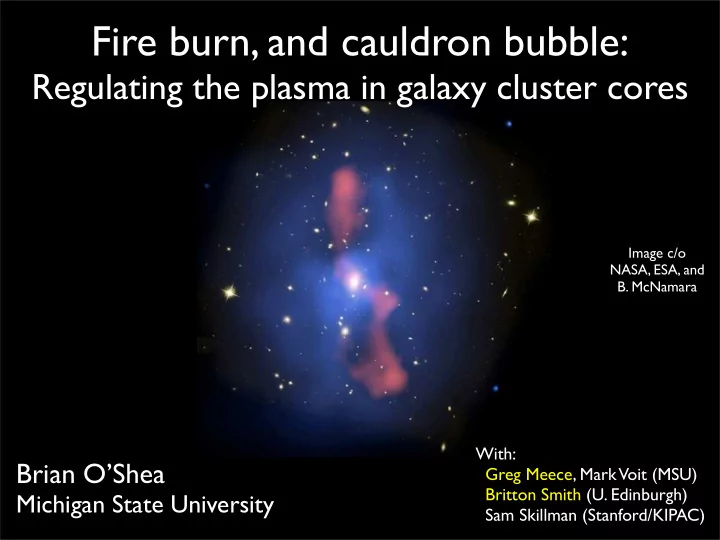

Fire burn, and cauldron bubble : Regulating the plasma in galaxy cluster cores Image c/o NASA, ESA, and B. McNamara With: Brian O’Shea Greg Meece, Mark Voit (MSU) Britton Smith (U. Edinburgh) Michigan State University Sam Skillman (Stanford/KIPAC)
[ many thanks to Christoph for providing an introduction ]
Abell 1689 Image c/o NASA (HST)
Abell 1689 Image c/o NASA (HST + Chandra)
Cool core vs. non-cool-core clusters From Henning et al. 2009, ApJ, 697, 1597
The cool core problem Peterson & Fabian 2006
How to heat the cluster core? • Merger shocks/turbulence/sound waves • Cold clump accretion • Supernova feedback • Cosmic rays • Thermal conduction • AGN feedback (of various sorts) • (probably many more ideas)
McNamara+ Rafferty+ 2006
Important clue: Cluster entropy and AGN activity Central AGN is a radio source if K 0 < 30 keV cm 2 Cavagnolo+ 2008 note: K = k b Tn e-2/3
What could generate and regulate the (possibly stable) multiphase medium that feeds the AGN?
Thermal conduction with Britton Smith (Edinburgh), Mark Voit, David Ventimiglia (MSU), Sam Skillman (Stanford/KIPAC) Smith et al. 2013, ApJ, 778, 152
Conduction may be important in regulating cluster cores Voit et al. 2008, ApJL, 681, L5
A study of conduction in the ICM • AMR simulations of cluster formation • N-body + hydro, primordial+metal cooling, star formation and thermal feedback (no AGN yet!) • Isotropic conduction with f sp = 0, 0.01, 0.1, 0.33, 1 • 10 individual clusters run, identical except for f sp . Smith, BWO et al. 2013
Are conduction effects observable?
Radial profiles • Density Temperature Entropy
Radial profiles Density Temperature Entropy
Does conduction affect gas condensation? R F S d e z i l a m r o N Time
Conduction... • increases T core by 20-30% and makes cores slightly puffier • Slightly enhances star formation in BCG - maybe also slightly enhances AGN feedback? • Different/more powerful feedback mechanisms (AGN?) required to remove core gas and suppress star formation
Exploring thermal instability in cluster cores (exploring the Anything Goes Now hypothesis) Meece, O’Shea & Voit 2014, in prep.
Hypothesis: Gas in global thermal balance can form a multiphase intracluster medium if the ratio of cooling time to free-fall time is small enough. (McCourt et al. 2012; Sharma et al. 2012) How robust is this to feedback mechanism and plasma structure?
Simulations • 2D cartesian/cylindrical and 3D spherical, fixed gravitational potential • Control density, temperature structure of gas • Heating balances cooling at every height/ radius: input energy in various ways. • Ratio of cooling time to dynamical time set at 1 scale height (unless constant everywhere) Meece, O’Shea & Voit 2014, in prep.
t cool /t ff t cool /t ff = 0.1 = 0.34 Colorbar: density t cool /t ff t cool /t ff = 1.17 = 3.98
t cool /t ff t cool /t ff = 0.1 = 0.34 Colorbar: density t cool /t ff t cool /t ff = 1.17 = 3.98
t cool /t ff t cool /t ff = 0.1 = 0.63 Cylinder Colorbar: density Planar
Creation of a multiphase medium... • Can create a multiphase medium even in the presence of global thermal equilibrium in many circumstances • Depends primarily on the local ratio of cooling and free-fall times (t cool < t ff ) • Rate of cold gas creation is only somewhat affected by geometrical effects • Rate of accretion does seem to depend significantly on how energy feedback occurs
Main points • Thermal conduction may be able to enhance cooling of gas in some circumstances, but globally does not affect the structure of the cluster. • Multiphase medium formation/gas accretion/AGN feeding is not a particularly robust problem as we have characterized it. Maybe this is a good thing. Anything Does Not Go!
Recommend
More recommend